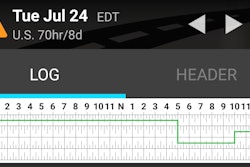 Truckers can continue to operate as they have since December 2014, meaning 34-hour restarts do not require two 1 a.m. to 5 a.m. periods. The 34-hour restart can also be used as often as truckers like.
Truckers can continue to operate as they have since December 2014, meaning 34-hour restarts do not require two 1 a.m. to 5 a.m. periods. The 34-hour restart can also be used as often as truckers like.The results of a new study confirm that truckers’ 34-hour restarts will not require two 1 a.m. to 5 a.m. periods and will not be limited to once per week.
The study has not yet been made public, but a letter issued by the Department of Transportation’s Office of Inspector General confirms the report’s conclusions. To comply with an order from Congress, the study’s results dictate the removal of the 1 a.m. to 5 a.m. provision and the removal of the once-weekly limit.
Congress suspended the 1 a.m. to 5 a.m. requirement and the once-weekly limit in December 2014, pending the issuance of the U.S. DOT’s study. The long-awaited report from the Department shows those provisions did not enhance safety, according to an OIG update issued last week, at least to a degree to justify them.
The DOT’s Federal Motor Carrier Safety Administration will likely need to issue a formal notice to permanently remove the rules, but the regs have been suspended since a December 2014-issued notice. The report does not change the rules truckers’ currently operate under.
A DOT spokesperson says the Department is in the “final stages of reviewing the study” before sending a final report to Congress, as required by a 2014-passed budget act.

The DOT’s OIG on Thursday sent a letter to Congress signing off on the DOT study, saying it agreed with the report’s conclusions and that the DOT followed Congress’ directives in completing the research.
The study found that truckers abiding by the July 1, 2013, regulations — those requiring the early morning periods to be included in the restart — operated no more safely than truckers not abiding by the rules, the OIG letter says.
More than 200 drivers were studied for the DOT’s report, which was executed by FMCSA and Virginia Tech. The drivers were divided into two groups. One group followed the more restrictive 2013 rules and the others were free to use the restart as they wanted.
The study “did not explicitly identify a net benefit from the use of the two suspended provisions of the restart rule on driver operations, safety, fatigue and health,” the OIG’s letter states.
Researchers compared drivers’ schedules and analyzed events like crashes and near crashes, as well as driver alertness and health.
The more restrictive hours of service rules took effect in July 2013, prompting widespread criticism by both fleets and drivers for preventing truckers from returning to duty until 5 a.m. after a restart, even if the restart had spanned a full 34 hours.
Chief arguments against the regulations were that it pushed drivers into early morning rush hour traffic — which caused safety and operational concerns — and that FMCSA issued the rule with little scientific evidence to back up the restrictions.
Congress cleared legislation in December 2014 to halt the regulations and require FMCSA to perform the 34-hour restart study. Congress set the bar high for the 2013 rules to go back into effect, requiring the study to show exceeding safety and health benefits for drivers’ operating under the 2013 rules.












